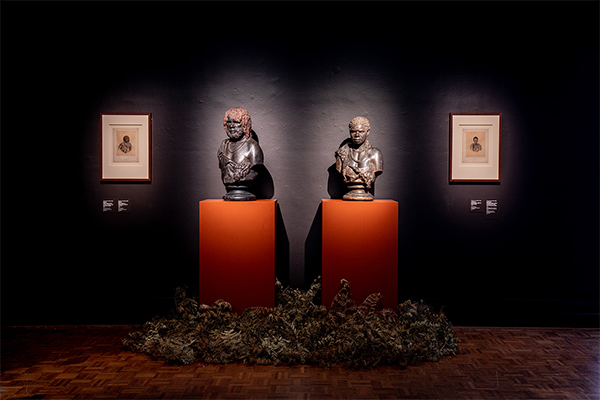Callan Morse, taypani milaythina-tu: Return to Country showcases Aboriginal artists at Tasmanian gallery, 5 October 2022
The Tasmanian Museum and Art Gallery have launched taypani milaythina-tu: Return to Country, an exhibition combining historically significant Tasmanian Aboriginal cultural objects from around the world with responses from 20 Tasmanian Aboriginal artists.
The Tasmanian Museum and Art Gallery has launched taypani milaythina-tu: Return to Country, an exhibition which features responses from 20 Tasmanian Aboriginal artists and cultural makers to stories of ancestors and their cultural objects held in institutions around the world.
Developed from years of gatherings and decades of research by the Tasmanian Aboriginal community, the exhibition includes a combination of Tasmanian Aboriginal cultural objects sourced from collections around the world in combination with artistic and cultural responses from current Tasmanian Aboriginal people.
The exhibitions aim is to facilitate Aboriginal reconnection with cultural objects that left the island in colonial times, as well as develop relationships with institutions external to Tasmania.
Exhibitors include Zoe Rimmer, a pakana woman from a large extended family from Flinders and Cape Barren Island with ancestral connections to the north east coast of Tasmania who also works in TMAG’s cultural heritage management sector.
Exhibiting rikawa niyakara (bull kelp dreaming) in collaboration with pakana woman Theresa Sainty, Ms Rimmer said after viewing cultural material from various collections first-hand, the exhibition aims to share cultural objects with the public and rebuild cultural practises of Tasmanian Aboriginal people.

“I have personally had the unique experience of visiting precious cultural material in collection stores, but this is a privilege that many in our community cannot share,” she said.
“To be able to bring some of our most unique cultural heritage material home through taypani milaythina-tu is an incredible opportunity for reconnection and healing.
“The possibilities to help revitalise and inspire cultural practices from this type of engagement are endless.”
The project has been led by TMAG’s First Peoples Art and Culture team, who have sourced Tasmanian Aboriginal cultural objects for the exhibition from as far away as Europe and North America.
First Peoples Art and Culture team curator Julie Gough said the return of the cultural objects from many afar institutions was significant for Tasmanian Aborignal people and could act as a precursor for further returns.

“The cultural material returned on loan for this exhibition is a small example of our globally dispersed cultural heritage, and there is much work still to be done,” she said.
“Musée du Quai Branly in Paris and the British Museum in London hold the oldest surviving rikawa (kelp containers), whilst the Field Museum in Chicago holds a unique cordage necklace, and Pitt Rivers Museum in Oxford holds the only known model reed canoe.
“Long-missing shell necklaces, twined baskets, wooden, stone and bone tools, domestic objects and artworks have returned to lutruwita from the Victoria and Albert Museum in London, the National Museum of Scotland, Edinburgh, the University of Cambridge Museum of Archaeology and Anthropology, Cambridge, the World Museum in Liverpool, and the Derbyshire Record Office in Matlock.”
Ms Gough said institutions within Australia have also contributed cultural objects to the exhibition.
“These objects join those sent from Museums Victoria in Melbourne, the Queen Victoria Museum and Art Gallery in Launceston, Libraries Tasmania, the Royal Society of Tasmania, and the National Gallery of Australia in Canberra, as well as some held in TMAG,” she said.

TMAG Director Mary Mulcahy said the combination of historically significant cultural objects and contemporary responses from Tasmanian Aboriginal people made the exhibition unique.
“We are so pleased to be presenting not only the ancestral objects on loan, but also the array of contemporary artworks the 20 Tasmanian Aboriginal artists have created in response,” she said.
The response artworks include paintings, sculptures and audio / video instillations, all which present a reconnection between Tasmanian Aboriginal people, objects and Country.
The exhibit was opened by a weekend of talks from Tasmania Aboriginal artists featured in the exhibition and curators from international institutions.
taypani milaythina-tu: Return to Country will be TMAG’s major spring-summer exhibition for 2022-23, and follows on from previous Tasmanian Aboriginal community and TMAG partnership projects kanalaritja: An Unbroken String (2016–20) and tayenebe: Tasmanian Aboriginal Women’s Fibre Work (2008–11)
The exhibition runs from October 1 to February 12 2023.
taypani milaythina-tu: Return to Country exhibiting artists
Andrew Gall – Item 272969
Bianca Templar – Cultural Strength; Strong Black Womin – Forever Culture (group work)
Bonnie Starick – Blak Enough
Cheryl Mundy tremanya – If These Walls Could Talk (group work)
Cheryl Rose – The Red Dress
Colleen Mundy – Unfinished; Unfinished basket
Dave mangenner Gough – leewuree taymi ningina / firestick never given
Janice Ross – nuratinga milaythina kani mana- mapali (Country holding our stories); niplin (Country of the lowreene people)
Jeanette James – niyakara kurina (eaglehawk dreaming)
Jillian Mundy – If These Walls Could Talk (group work)
Lillian Wheatley – Unravelling Weave; Strong Black Womin – Forever Culture (group work)
Lola Greeno – Honouring Lucy Beeton
Louise Daniels – Nungu – Box 25
maikutena Vicki-Laine Green – Reviving Culture into the Future (featured in group work Strong Black Womin – Forever Culture)
Rex Greeno – trukati (high tide); laymina (lagoon); ningher
Takira Simon-Brown – Stolen Journey
Teresa Green – Reviving Culture into the Future (featured in group work Strong Black Womin – Forever Culture)
Theresa Sainty – rikawa niyakara (Bull Kelp Dreaming) (group work)
Zoe Rimmer – rikawa niyakara (Bull Kelp Dreaming) (group work)

